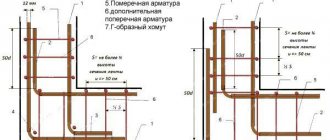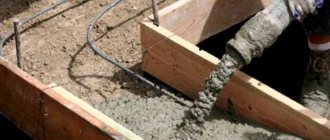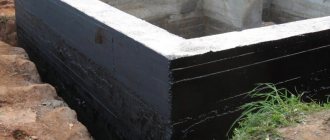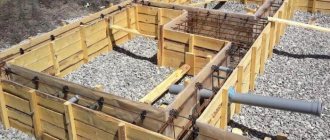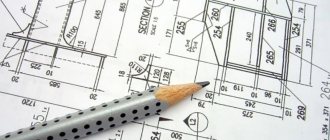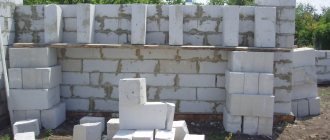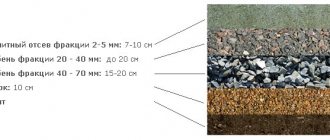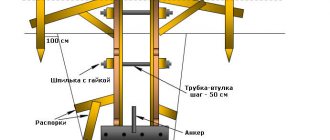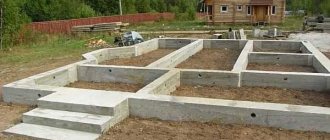In the process of creating a foundation, the main attention is paid to the requirements for constructing formwork and pouring concrete. However, issues affecting the formwork removal procedure are no less important. In particular, it is necessary to take into account the time interval during which the concrete gains sufficient strength
, as well as the technology for dismantling the structure itself.
Information collected from laboratory studies can also be used to develop a concrete repair mixture design. As with other historic structures, concrete structures are cleaned for several reasons: to improve the appearance of the concrete, as a routine maintenance measure, or in preparation for renovation. The first question to consider is whether the historical concrete structure should be removed at all. If cleaning is required, you should choose the gentlest system that will be effective.
Three main methods are used to clean concrete: water methods, abrasive surface treatments, and chemical surface treatments. Low pressure water or steam purification can effectively eliminate surface contamination from sound concrete; however, fragile or damaged surfaces require maintenance. Additionally, water and steam methods are generally not effective in removing stains or heavy soiling. Powerful, high-pressure water washing is sometimes used to clean or remove coatings from sound, high-strength concrete, but high-pressure washing is usually damaging and is not suitable for concrete on historic structures.
Standard time for removing formwork
There is an opinion that the optimal period for curing the foundation is 28 days
.
However, the answer to the question of when to remove the formwork after pouring concrete will be individual
.
The main standard parameter that should be taken into account when determining the time a structure is ready for dismantling is tempering strength
. This characteristic, in turn, depends on the following data:
Impact echo testing is performed on the concrete slab to help determine the depth of wear. In this method, a short pulse of energy is injected into the structure and a transducer mounted on the impact surface of the structure receives the reflected input waves or echoes. These waves are analyzed to help identify flaws and deteriorations in the concrete.
When used with proper control and at very low pressures, microabrasive surface treatments using very fine particles such as dolomite limestone powder can sometimes clean effectively. However, micro-abrasive cleaning can change the texture and reflectivity of the concrete surface. Some concretes can be damaged even by fine particles applied at very low pressures.
- Type and dimensions of the structure
; - Brand of concrete used;
- Ambient temperature
; - Other hardening conditions;
- Load size
.
Chemical surface treatments can effectively clean, but can also alter the appearance of concrete by bleaching the concrete, removing paste, etching aggregate, or otherwise altering the surface. Cleaning detergents or mild diluted acid cleaners may be suitable for removing stains or heavy soiling. Cleaners containing strong acids such as hydrochloric acid or hydrofluoric acid, which can damage concrete and are harmful to people, animals, site features and the environment, should not be used.
The main criterion when determining the waiting time for concrete to harden is its type. In particular, the tempering strength for heavy concrete and mortars with porous additives is 50%, and with autoclave hardening the OP will reach 100%. When the structure reaches its maximum strength, the formwork can be dismantled. In other cases, the same time period of 28 days
. According to the standards, concrete for the foundation must acquire sufficient load strength no later than this period.
For any purification process, trial samples must be performed prior to full-scale implementation. The goal of a cleaning program should not be to return the structure to a new appearance. Concrete can age gracefully, and as long as the contamination is not severe or harmful, many structures can still be assessed without extensive cleaning.
Maintenance and repair methods
Caring for historic concrete is often thought of in terms of proper cleaning to remove unsightly dirt or contaminating materials. However, implementing a general maintenance plan for a historic structure is the most effective way to protect historic concrete. For example, lack of maintenance of roofs and drainage systems can contribute to water damage associated with adjacent concrete structures. Reusing anti-oxidation salts in winter climates can fish out the surface of old concrete and can also promote decomposition in embedded steel reinforcements.
In addition, there are visual signs indicating that the formwork can be removed. For example, to determine when to remove the formwork from a strip foundation, you should pay attention to the plywood panels
. If they begin to move away from their original position, this indicates that the concrete is releasing water and the formwork structure can be dismantled. It usually takes 7 to 10 days before gaps form between the plywood and the concrete base.
The influence of temperature on the time of stripping
Inadequate protection of concrete walls adjacent to driveways and parking areas may result in the need for repairs later.
Preserving historic concrete involves regularly inspecting the concrete to establish baseline conditions and determine needed repairs. Inspection objectives include protection control systems, including seal joints, expansion joints and protective coatings; consideration of existing conditions for disaster development, such as cracking and delamination; compliance with registration conditions; and developing and implementing a cyclic repair program. To more accurately determine these deadlines, specialists use monitoring tools. It is where the calculations of concrete viscosity and thickness are carried out, taking into account the characteristics of the aggregates used. From the data obtained, the time for more suitable formwork removal is calculated.
Stripping of monolithic unheated structures
Figure 17. The 63rd Street Beach House was built on the Chicago waterfront. High-carbon concrete on all sides of the beach house was used for many buildings in Chicago's parks as an alternative to more expensive stone construction. Photography: Leslie Schwartz Photography. Concrete failure included cracking, spalling, and spalling caused by corrosion of embedded reinforcing steel and concrete damage due to freeze-thaw cycling. Different sizes and types of aggregates were compared to match the original concrete materials.
Monolithic foundations, which are installed without the use of heating technologies using a thermos, are subjected to stripping in accordance with the regulatory document of the TR series. The following types of formwork fall under this standard: side panel formwork on foundations, columns, walls and beams, load-bearing panel elements, structures with prestressed reinforcement, load-bearing formwork with spans of about 6 m, etc.
For comparison with the original concrete, mock-ups of the concrete repair mixture were prepared. Considerations included aggregate type and size, cement color, proportions, aggregate exposure, and surface finish. The craftsman created the surface to reproduce the original appearance in the layout on the structure. Here he used a nylon bristle brush to remove loose paste and expose the aggregate, creating a variable surface to match the adjacent original concrete.
Sealants are an important part of maintaining historic concrete structures. Elastomeric sealants, which have replaced traditional oil-based fillers for many applications, are used to seal cracks and joints to keep moisture out and reduce air infiltration. Sealants are commonly used in the perimeters of windows and doors, at the joints between concrete and other materials, and in hanging to or through walls or roofs, such as lamps, signs, or exterior plumbing fixtures.
To determine the time to remove the formwork after pouring the crossbar, column and other structures of this group, the indicators of the actual load relative to the standard one should be taken into account. The established waiting time range is from 6 to 72 hours
.
The main parameter for setting a specific time interval is the load, which can vary from 70 to 100% relative to the design one
.
If used to repair cracks in historic facades, the finished sealant application must be considered as it may be visually intrusive. In some cases, sand can be transferred to the surface of the sealant to help hide the repair.
Urethane and polyurethane sealants are often used to seal joints and cracks in concrete structures, paving slabs and walkways; these sealants provide a service life of up to ten years. High-performance silicone sealants are also often used with concrete, as they provide a wide range of movement capabilities and a service life of 20 years or more. Some silicone sealants can stain adjacent materials, which can be a problem with more porous concrete, and can also accumulate dust and dirt.
It is important not to forget that full loading of the structure is possible only from the moment when the concrete base acquires full strength in accordance with the design indicator
.
In the future, all activities related to work on a site with a reinforced concrete structure and its maintenance must be carried out with the condition that the strength of the concrete structure is at least 1.5 MPa
. If intermediate span supports are used, the maximum permissible strength for stripping can be reduced. In other words, the presence of supports increases the turnover of the concrete mass and reduces construction time.
The effectiveness of sealants for sealing joints and cracks depends on many factors, including proper surface preparation and application. Sealants should be considered as part of regular maintenance checks as these materials degrade faster than their substrates and need to be replaced periodically as part of a maintenance cycle.
Repair of historic concrete may be required to correct deterioration because the original design and construction does not provide long-term durability or facilitates a change in use of the structure. Examples include increasing concrete cover to protect reinforcing steel and reducing water intrusion into a structure by repairing joints. Any such improvements must be carefully evaluated for compatibility with the original design and appearance. Care is required in all aspects of historic concrete repair, including surface preparation; installation of formwork; development of concrete mixture design; and placement, consolidation and curing of concrete.
Columnar-tape: when to remove formwork
This is a combined type of foundation, where the main load is borne by the pillars, and the tape serves as a connecting link between them, performing the functions of a grillage. Column-and-tape is applicable for massive construction projects where a large load on the base is expected.
Since this type of structure can be used for construction on sloping sites, the length of the formwork is taken into account when calculating the time to remove the formwork. The requirements for the maturation of concrete and the time when foundation formwork can be removed are more stringent here:
- for horizontal and inclined structures up to 6 meters in length, the recommended concrete strength should be at least 70%;
- for horizontal and inclined architectural elements over 6 meters in length - 80% of the established strength.
To assess the maturity of concrete, a reference element of the foundation formed during its pouring should be used. When its performance is satisfactory, the formwork can be removed.
To get an idea of the maturation time of concrete depending on the ambient temperature, you can use the following indicators:
- -3 °C - concrete ripening is possible only with external forced heating of the structure;
- 0 °C - ripening to half strength is possible on the 14th day;
- +5 °C - on the 7th day, concrete acquires 48% strength, on the 28th day - 77%;
- +10 °C - on the 5th day it matures by 50%, two weeks after pouring it reaches a strength of 72%;
- +20 °C - after three days the concrete is 50% hardened, on the 28th day it completely acquires the required strength;
- +30 °C - on the second day the strength indicator is 50%, and on the fifth day - 80%.
The calculations were based on concrete with grade strength M200 and M300. It is this material that is most often used in construction for pouring columnar and columnar-strip foundations. As temperature indicators, it is necessary to take average daily values, and not the maximum level that the air reached on the control day.
The influence of temperature on the time of stripping
The dependence of the time to gain strength on the temperature regime can be traced using the example of two concretes - Portland cement and Portland slag cement.
.
The first one, at a temperature of 10 °C or more, gains about 50% of the design strength in 5 days
, and a solution based on slag Portland cement under similar conditions reaches the same state in
2 weeks
.
For comparison, in winter, at negative temperatures, these periods can increase to 3 months
. And this is provided that the builders add anti-frost additives. Accordingly, in order to speed up the hardening process, it is better to use electric heating systems when carrying out winter concreting.
Effect of air humidity
An appropriate repair program addresses existing distress and reduces the rate of future deterioration, which in many cases is due to moisture-related problems.
The renovation program should include materials and methods that are compatible with existing materials in character and appearance and that provide good long-term performance. In addition, repair materials must withstand and withstand similar original materials. To achieve these goals, specific renovation projects should be divided into three phases: development of trial repair procedures, trial repair and evaluation, and repair work. Proper care also contributes to rapid strength gain. Concrete must be protected from direct contact with precipitation, exposure to the rays of the sun and wind. In addition, there is a common question about when to remove the formwork after pouring the floor, provided that optimal heat and humidity conditions are created for hardening. If regular watering is carried out, and during the day the concrete base is covered with a film, then, provided the temperature is positive, the formwork can be removed on average after 10 days.
For any given renovation project, the process of research, laboratory analysis, prototypes, mock-ups and full-scale renovations allows for continuous improvement of the renovation work as well as quality control measures. The trial renovation process provides an opportunity for the owner, architect, engineer and contractor to evaluate the concrete mix design and installation and finishing techniques for the renovation from a technical and aesthetic perspective. Final repair materials and procedures must match the original concrete in appearance while meeting established durability criteria.
In the technology of constructing monolithic structures, not only the competent installation of formwork, pouring the concrete mixture and caring for it during the period of strength development are considered important stages of work. No less important is a question that even experts cannot give a confident answer to. Among them, there have been debates for many years about when it would be more correct to remove the formwork from the foundation - before or after the generally accepted 28 days required for concrete to gain grade strength. It turns out that not everything is so clear in the regulatory documents, which indicate different terms and conditions that allow the dismantling of the auxiliary structure to begin. After how many days can the formwork be removed so that the concrete monolith does not collapse, and what are the consequences of its premature removal?
Information gathered through trial repairs and mock-ups is invaluable in refining construction documents before commencing an overall renovation project. When conducting surface preparation for historic concrete repairs, care must be taken to limit the removal of existing material while maintaining an adequate substrate for the repair. This is especially important when it comes to ornamentation and small details. Preparation for local repairs usually begins by removing concrete to determine the overall extent of the repair, then sawing around the perimeter of the repair area.
When to remove formwork from a strip foundation
In appearance, it resembles a reinforced concrete strip (closed or open contour), deepened into the soil by 1-1.65 m. The erected building structure rests with all its weight on the concrete strip, so it is necessary to ensure that the foundation is strong and the concrete reaches its maximum strength.
For all types of foundations, including strip foundations, one general principle applies: the formwork can be removed when the concrete has reached its maximum strength.
The speed at which strength is gained depends on several factors:
- indicators of temperature and atmospheric humidity;
- concrete grades;
- dimensions;
- the presence of additives in the solution;
- quality of care for finished formwork.
It is recommended to carry out foundation installation work in the autumn-spring season. At this time, the optimum air temperature is maintained - without hot days and frosts.
It is believed that the maturation period of concrete, when its strength reaches its maximum parameters, is 28 days. If builders are dealing with a strip foundation, it is recommended to wait until it reaches at least 50% of the strength specified by the cement brand. Only after this can the formwork be removed. The solution reaches such indicators if construction is carried out in the summer at high temperatures (up to 30 degrees) in 5-7 days.
What is formwork
The construction of a monolithic strip foundation begins with the installation of formwork, which is a box without a top cover or only vertical walls located at a distance from each other. The internal dimensions and configuration of the formwork correspond to the design dimensions and outlines of the underground structure. With the help of removable or non-removable panels, monolithic parts of a building with a rectilinear and complex shape are erected, which is one of the advantages of the technology. Other advantages include:
- no seams or size restrictions;
- efficiency;
- strength;
- possibility of self-filling;
- carrying out zero work without the use of lifting mechanisms.
The repair area must extend beyond the concrete failure area sufficiently to provide a sound underlay. When repairing concrete with exposed aggregate or other special surface texture, the edge of the saw blade may be too visual. To hide the edge of the repair, techniques such as lightly hand-scraping the edge of the patch can be used to hide the connection between the original concrete and the new repair material. The depth to which concrete needs to be removed may be difficult to determine without invasive probing of the repair area.
The formwork is installed around the perimeter of the monolithic foundation. The panels are fixed using universal fasteners, spacers and supports. To install a removable structure, choose materials that have a low degree of adhesion to concrete. The most common materials used are wooden boards, plywood, metal sheets or plastic.
This procedure greatly simplifies the dismantling of the formwork a few days after pouring the foundation. In this case, you will not have to remove wooden panels or boards using impact forces. As a result, the integrity of the monolith is not compromised.

